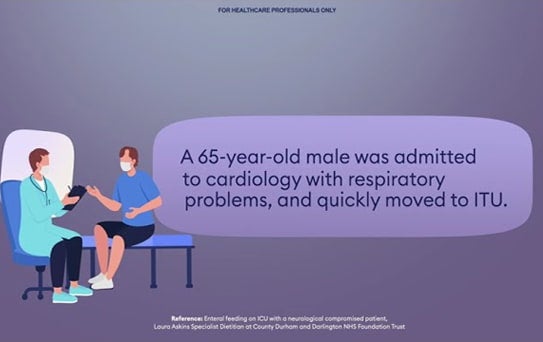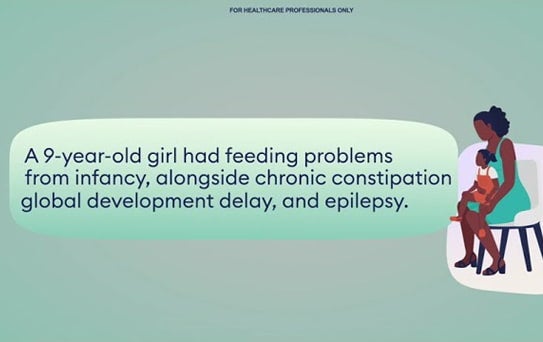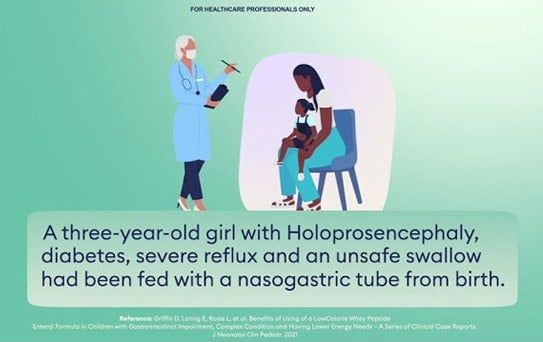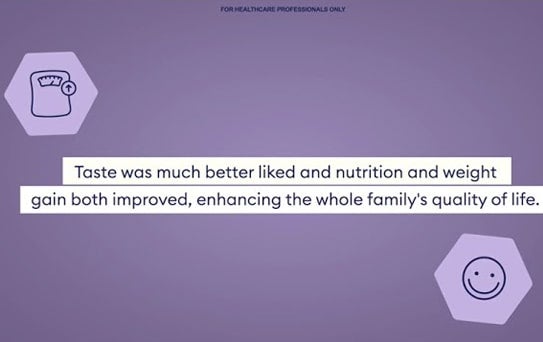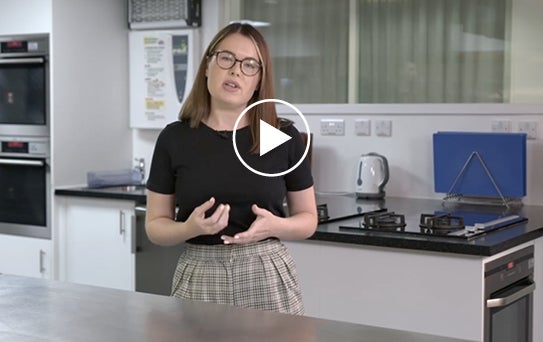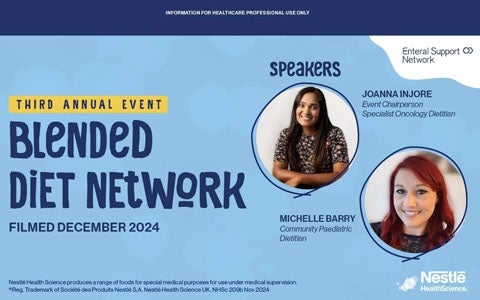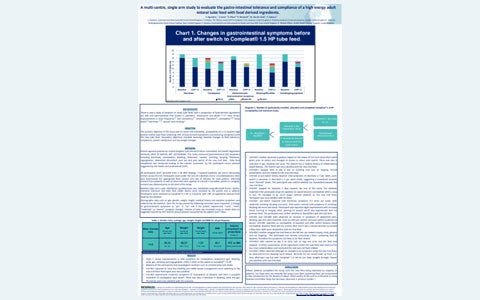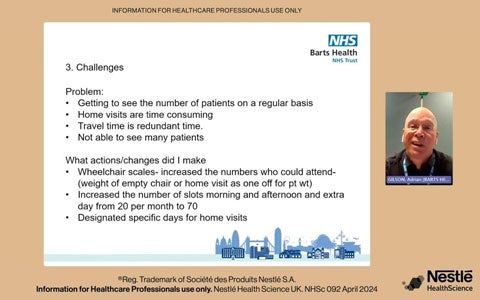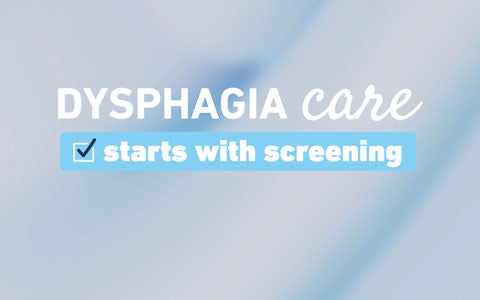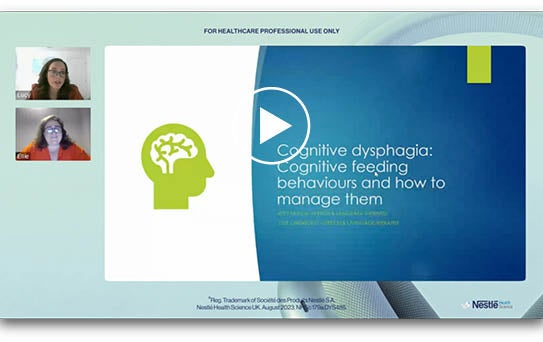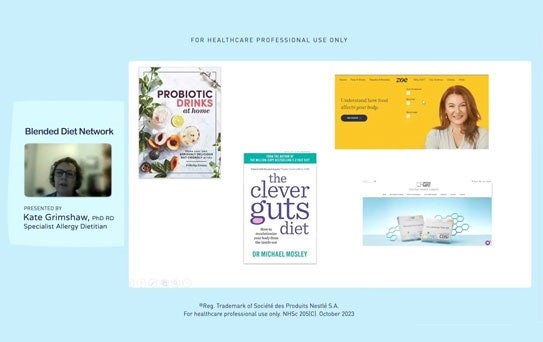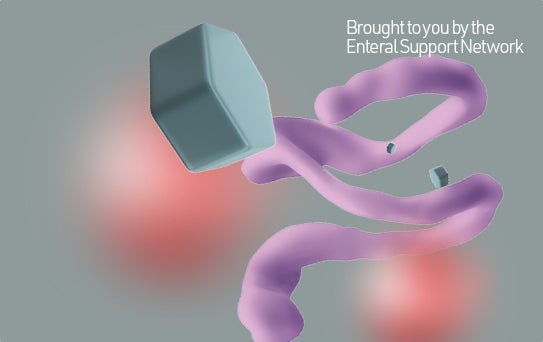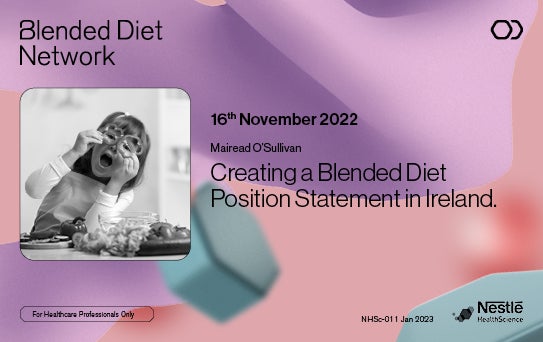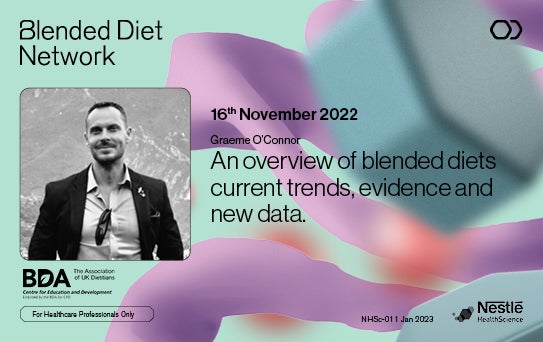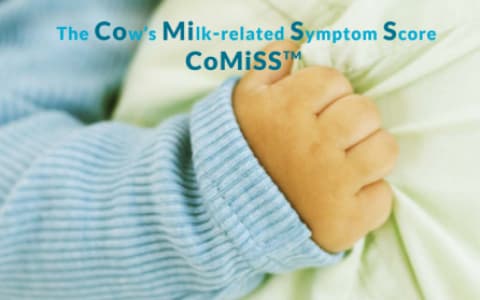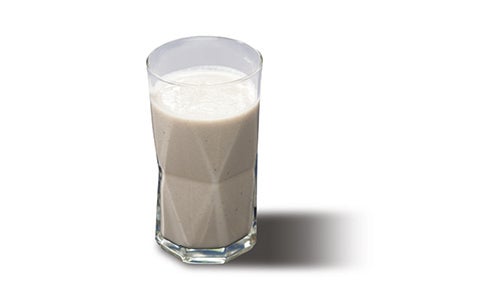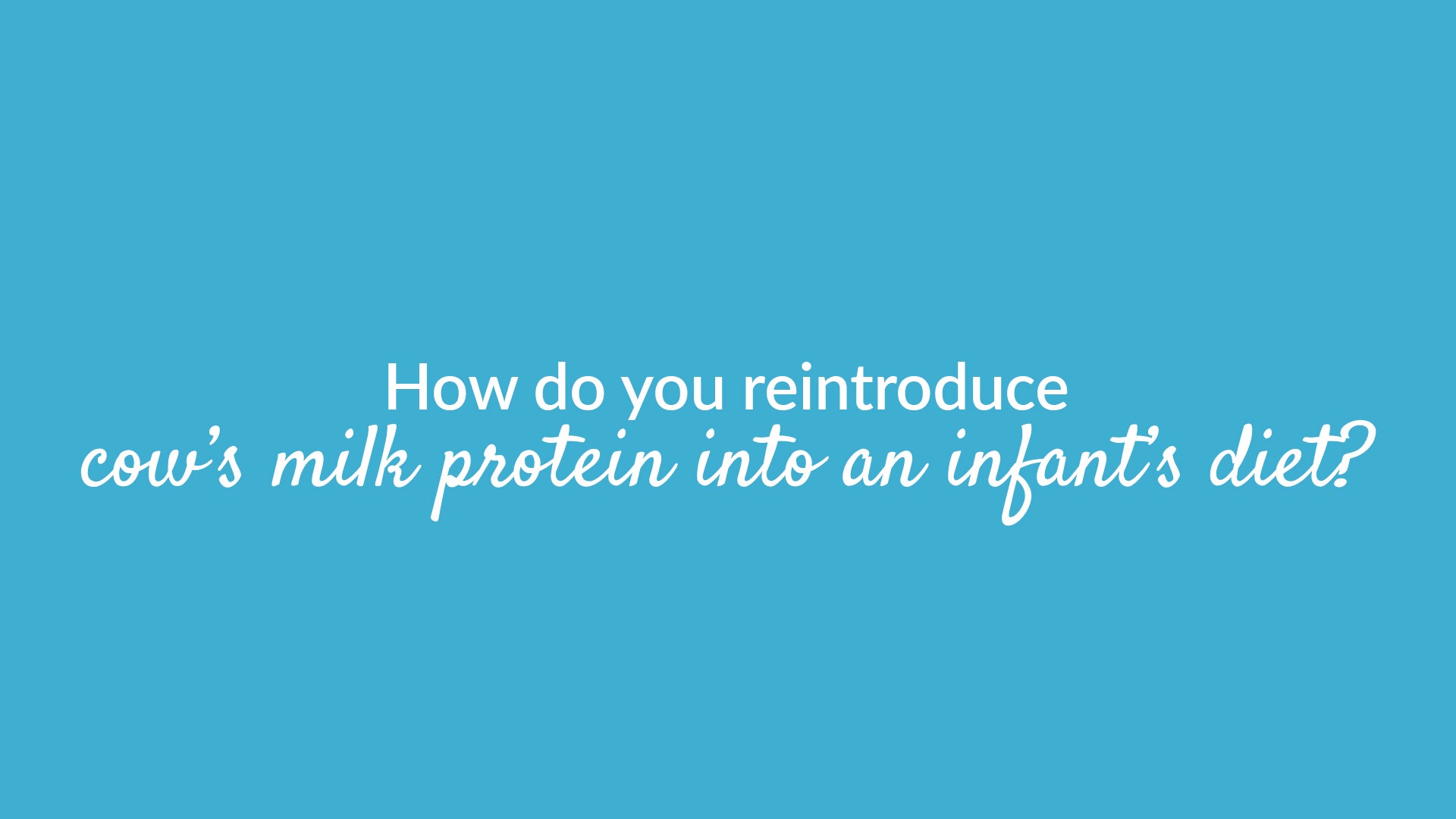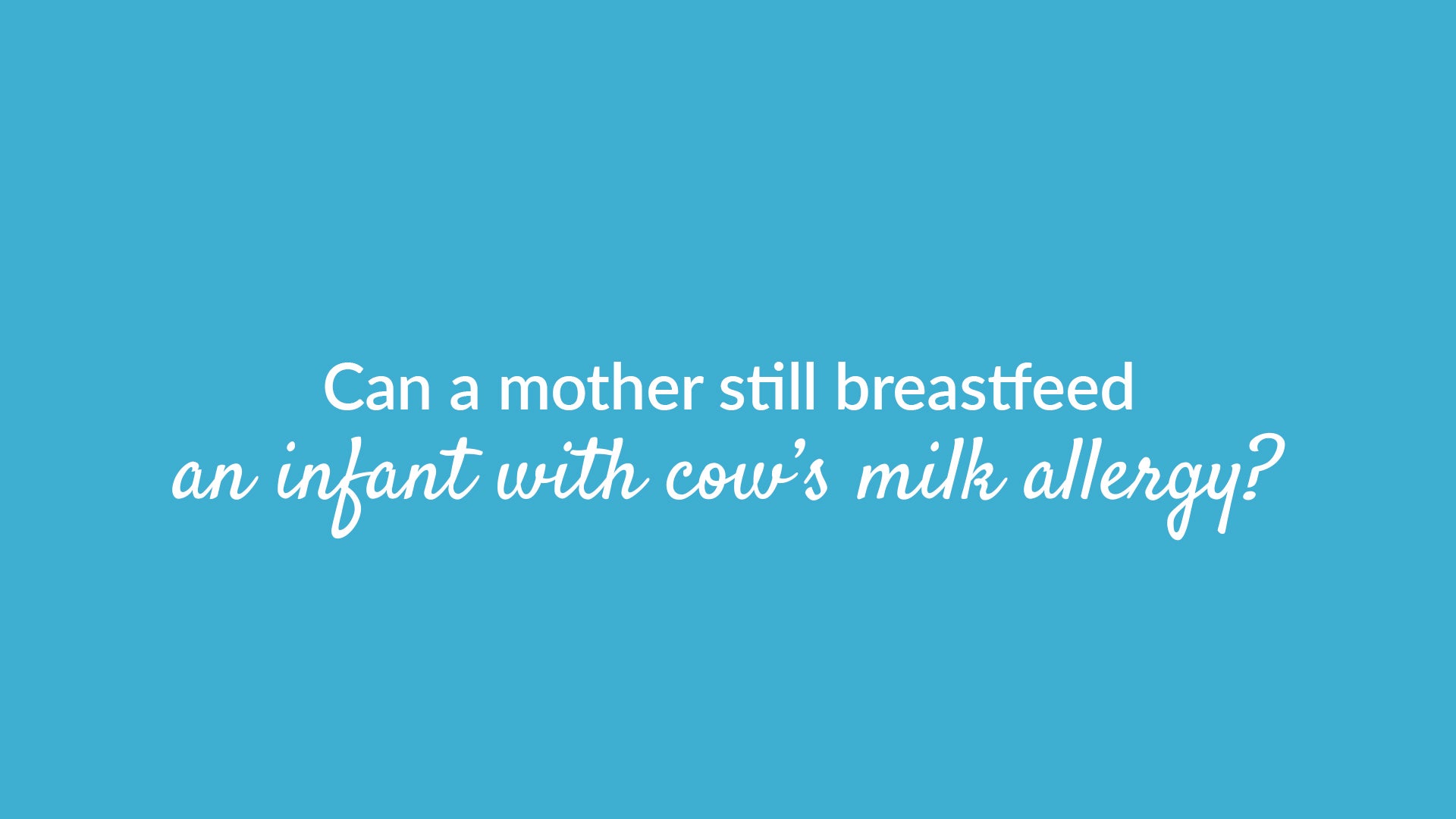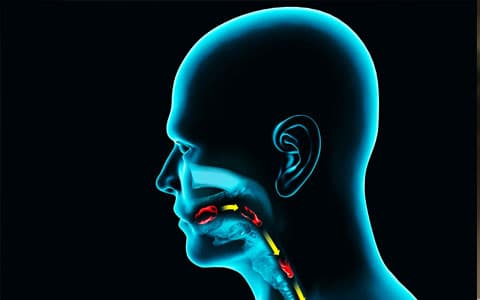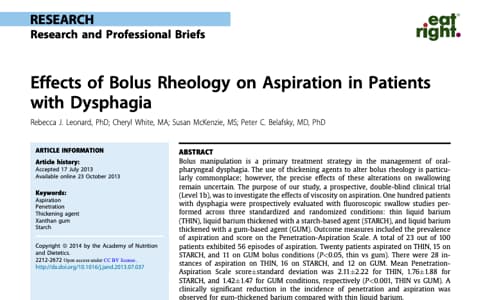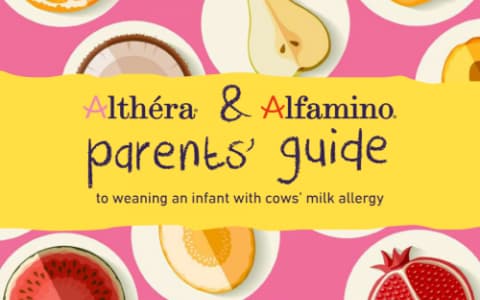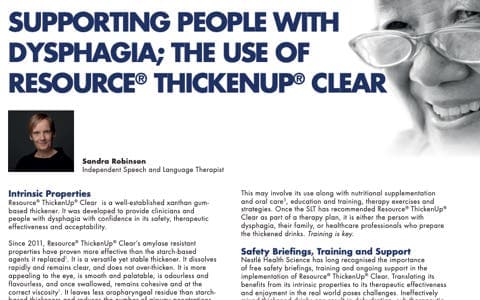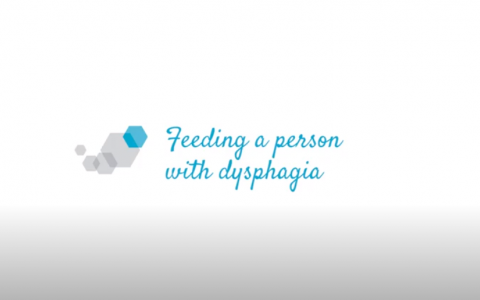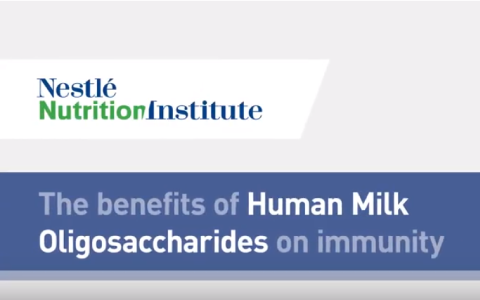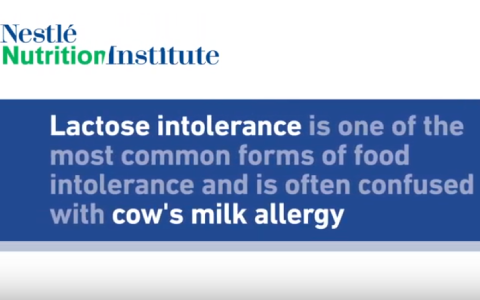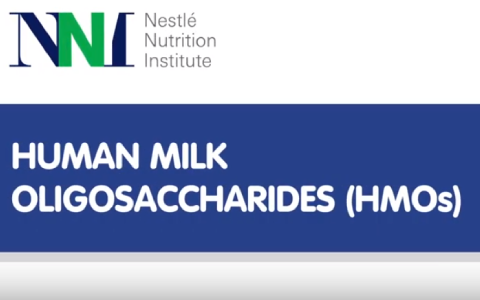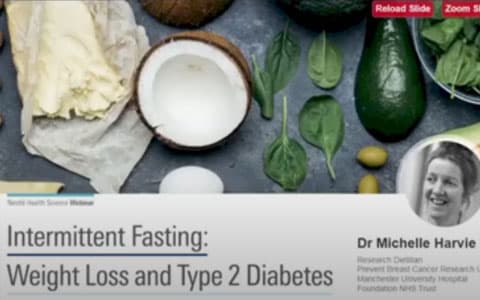Resources for
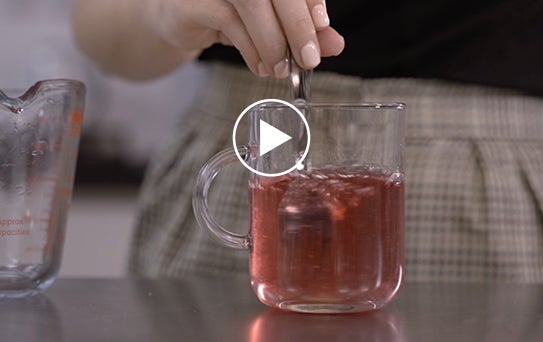
- Training Videos
- Videos
Dysphagia Safety Briefing: Correctly Mixing Thickened Drinks for Dysphagia Patients

- Training Videos
- Videos
Dysphagia Safety Briefing: Managing Dysphagia Through a Texture Modified Diet
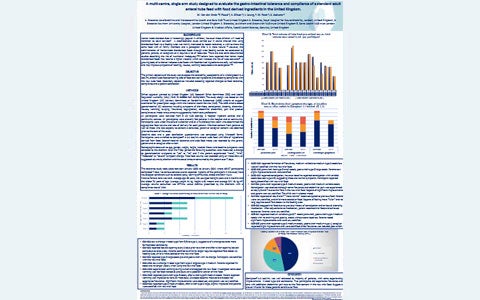
- Research
Tolerance and compliance clinical trial of a standard adult enteral tube feed with food-derived ingredients

- Research
A multi-centre, single arm study to evaluate the gastrointestinal tolerance and compliance of a high energy adult enteral tube feed with food derived ingredients

- Webinar
- Videos
CONNECTING THE DOTS WITH COMISS™ IN CLINICAL PRACTICE: Fast and Effective Evaluation of Symptoms Related to Cow’s Milk Allergy. Why is the Diagnosis of Cow’s Milk Allergy so Challenging?

- Webinar
- Videos
CONNECTING THE DOTS WITH COMISS™ IN CLINICAL PRACTICE: Fast and Effective Evaluation of Symptoms Related to Cow’s Milk Allergy. COMISS™: To raise the awareness of Symptoms related to Cow’s Milk Allergy

- Educational Videos
- Videos
Roundtable Discussion Series Episode 1: Home enteral feeding trends and changes to practice
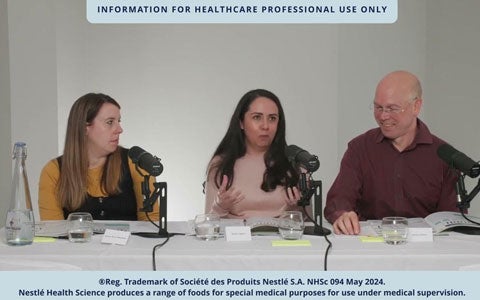
- Educational Videos
- Videos
Roundtable Discussion Series Episode 2: Clinical evidence for food-derived ingredients and gaps in the research
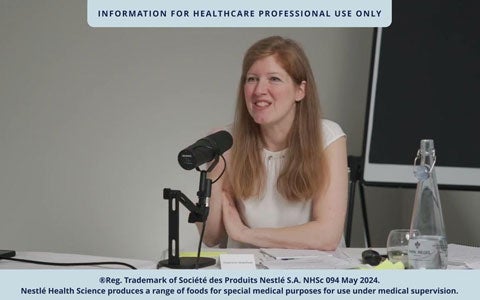
- Educational Videos
- Videos
Roundtable Discussion Series Episode 3: Practical considerations for the future of home enteral feeding and the potential of having a tube feed with food-derived ingredients for adults
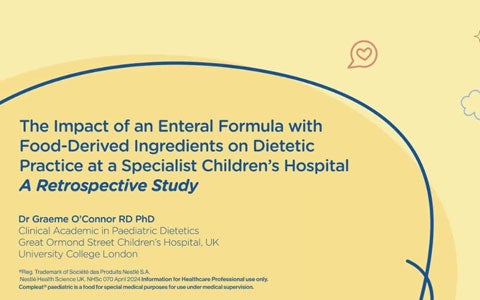
- Webinar
- Videos
The Impact of an Enteral Formula with Food-Derived Ingredients on Dietetic Practice at a Specialist Children’s Hospital
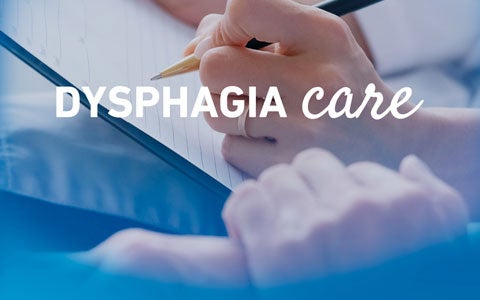
- Educational Materials
- Article
EAT-10 brochure explains the importance of, how and when to use the EAT-10 tool

- Educational Materials
History and Science behind the Eating Assessment Tool-10 (Eat-10): Lessons Learned

- Webinar
- Videos
Scientific evidence supporting the Eating Assessment Tool -10 (EAT-10) and its use in routine clinical practice

- Webinar
- Article
Real-World Evidence; Nutritional considerations for children with neurological impairment

- Webinar
- Videos
Real-World Evidence; Nutritional considerations for children with neurological impairment - Third Session
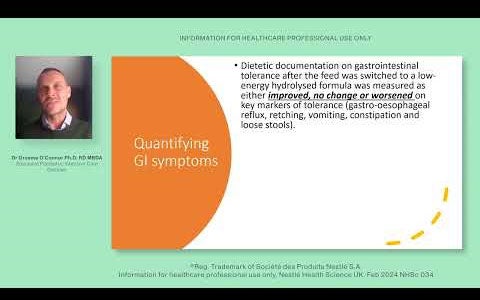
- Webinar
- Videos
Real-World Evidence; Nutritional considerations for children with neurological impairment - Second Session

- Webinar
- Videos
Real-World Evidence; Nutritional considerations for children with neurological impairment - First Session

- Research
- Article
Real-World Evidence - The Impact of a Low Energy Partially Hydrolysed Enteral Formula on Feeding Experiences in Children Tube Fed with Neuro-Disabilities

- Webinar
- Videos
Nutritional challenges for Adult Enteral Feeding; a deep dive into the patient journey
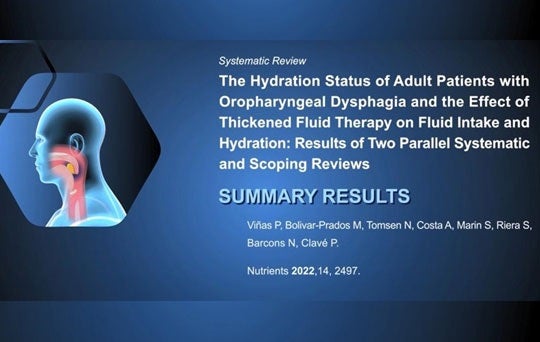
- Research
- Videos
The Hydration Status of Adult Patients with Oropharyngeal Dysphagia and the Effect of Thickened Fluid Therapy on Fluid Intake and Hydration: Results of Two Parallel Systematic and Scoping Reviews

- Videos
Blended – behind closed doors. Psychosocial and practical considerations for adults in the community

- Case Studies
Clinical Case Reports on the acceptability and tolerance of a High-Energy whey peptide-based Pediatric oral nutritional supplement in children aged over 12 months

- Webinar
- Videos
Cerebral Palsy – what the guidelines tell us and a case study using a formula with food-derived ingredients

- Educational Videos
- Videos
ESPGHAN 2023 – Nestlé Nutrition Institute symposium ‘New Trends in Enteral Nutrition for Children with Gastrointestinal Impairment’

- Webinar
- Videos
Fibre Maze: Influence on Gut Health and GI disorders - Dr Graeme O’Connor Ph.D RD, MBDA

- Webinar
- Videos
Supporting Acute Illness with Fibre: Why We Should Consider It and How We Can Apply It

- Case Studies
Fibres in paediatric functional gastrointestinal disorders. Practical considerations from clinical cases

- Case Studies
Tolerability and Safety of a Semi-elemental Enteral Formula with Partially Hydrolysed Guar Gum (PHGG) in Tube-fed Children Aged 1-4 Years: An Open-label, Single-arm Study

- Educational Materials
Intermittent bolus vs. continuous feeding in children receiving an enteral formula with food derived ingredients
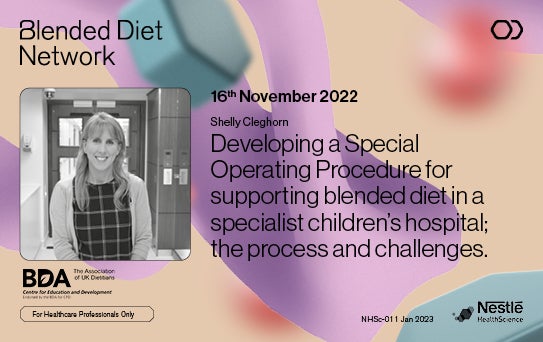
- Webinar
- Videos
Developing a Special Operating Procedure for supporting blended diet in a specialist children’s Hospital

- Webinar
- Videos
How do we best feed a hungry gut during paediatric allogeneic stem cell transplantation?

- Educational Materials
Summary-ESPEN practical guideline: Clinical Nutrition in cancer by M. Muscaritoli et al

- Case Studies
- Article
The use of peptide feed to resolve tolerance issues in jejunally fed post-op cancer patient

- Case Studies
- Article
The use of Peptamen products in the community with a Head and Neck Cancer patient

- Educational Videos
- Videos
The role of nutrition in stem cell transplants with Nirouz Zarroug and Janine Collins

- Webinar
- Videos
Overview of Parental and Enteral Nutrition Group (PENG) Guidelines - Applications in Hospital and Community Setting

- Webinar
- Videos
ESPGHAN 2022 - Nestlé Nutrition Institute Industry Symposium 'Clinical Experience of Enteral Nutrition with Real Food in Children'

- Educational Videos
- Videos
Can you swap from an amino acid formula (AAF) to an extensively hydrolysed formula (EHF)?

- Educational Videos
- Videos
How would you go about introducing an extensively hydrolysed formula or an amino acid formula?

- Educational Videos
- Videos
Could I recommend a carer adding anything to the formula to make it taste better?

- Educational Videos
- Videos
Can you concentrate an extensively hydrolysed formula or amino acid formula?

- Educational Videos
- Videos
Can you use a soya formula for the dietary management of cows’ milk allergy?

- Educational Videos
- Videos
How many patients should tolerate an extensively hydrolysed formula (EHF)?

- Educational Videos
- Videos
What’s the difference between an extensively hydrolysed formula (EHF) and an amino acid formula (AAF)?
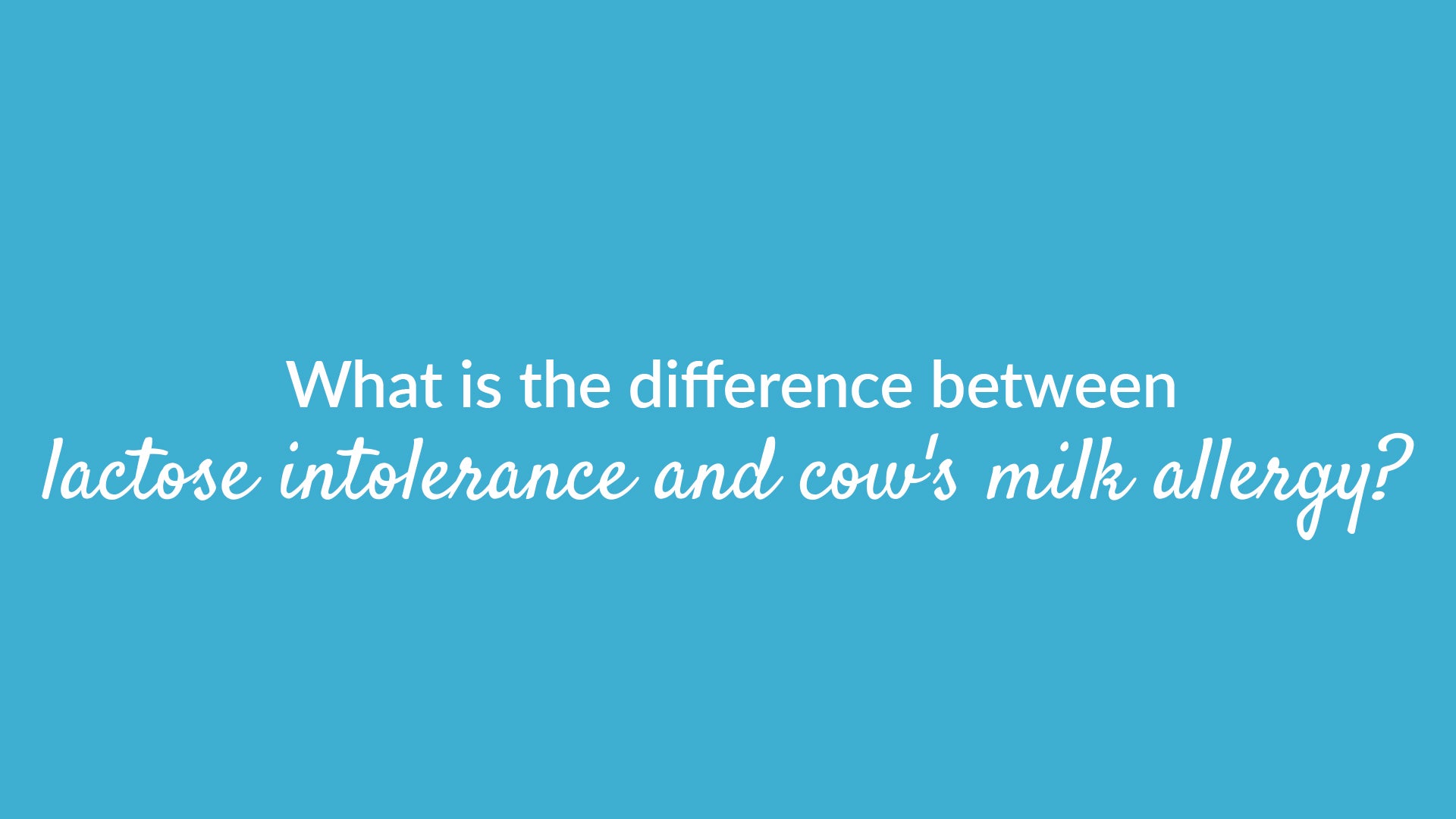
- Educational Videos
- Videos
What is the difference between lactose intolerance and cows’ milk allergy?

- Webinar
- Videos
Webinar & Study: Real-world evidence - paediatric tube feed containing food-derived ingredients
- 46:39

- Webinar
- Videos
Webinar: Nutritional challenges in managing complex patients from children to adults
- 1:15:29

- Educational Videos
- Videos
Case studies – Peptamen Junior 1.5kcal/ml ONS, from the Acceptability and Tolerance Study

- Research
- Article
Experience within an Acute Paediatric Centre using an Enteral Tube Feed Containing Food-Derived Ingredients

- Educational Videos
- Videos
Webinar: Simplifying the management of high and low energy requirements in complex needs children

- Research
- Article
Benefit of Including Food-Derived Ingredients in Enteral Nutrition Formulas: Practical Experience from Clinical Cases.

- Case Studies
- Article
Resource® ThickenUp Clear™ - a smooth transition and successful introduction in Leeds

- Case Studies
- Article
A Comparative Study Between Modified Starch and Xanthan Gum Thickeners in Post-Stroke Oropharyngeal Dysphagia

- Case Studies
- Article
Acceptance, Compliance, and Tolerance of a Novel Xanthan Gum- Based Thickener* in Oropharyngeal Dysphagia Patients

- Case Studies
- Article
Changing from a starch-based to gum-based thickener product: A step in the switching process
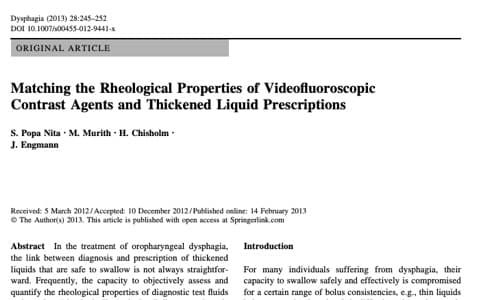
- Case Studies
- Article
Matching the Rheological Properties of Videofluoroscopic Contrast Agents and Thickened Liquid Prescriptions

- Product Resources
- Article
Eat10 – A quick and easy screening tool, validated to identify those at risk of Dysphagia
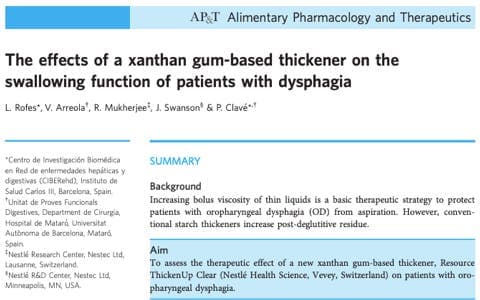
- Case Studies
- Article
The effects of a xanthan gum-based thickener on the swallowing function of patients with dysphagia
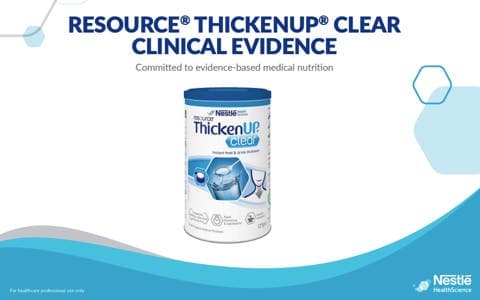
- Case Studies
- Article
Sensitivity and Specificity of the Eating Assessment Tool and the Volume-Viscosity Swallow Test for Clinical Evaluation of Oropharyngeal Dysphagia

- Case Studies
- Article
Performance-based preference for a novel xanthan gum-based thickener among clinicians treating dysphagia patients
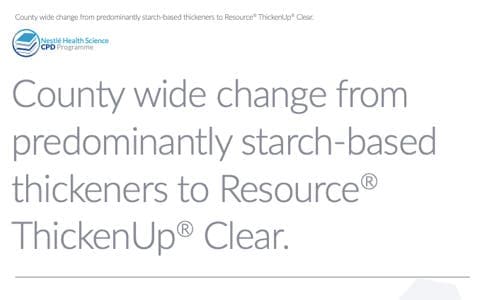
- Case Studies
- Article
County wide change from predominantly starch-based thickeners to Resource ThickenUp Clear

- Case Studies
- Article
Educational Webinar - Appropriate Use of Thickened Liquids in Dysphagia Management

- Case Studies
- Article
A practical approach to managing a CMA infant with an extensively hydrolysed formula

- Research
- Article
Safety and Efficacy of a new extensively hydrolyzed formula for infants with Cows’ Milk protein allergy

- Case Studies
- Article
The importance of having a choice of eHF and AAF milks in the management of CMA

- Research
- Article
The prevalence of lactose intolerance in children with non-IgE-mediated gastrointestinal cows’ milk protein allergy (CMA)

- Case Studies
- Article
Hypoallergenicity of a whey-based, extensively hydrolysed infant formula prepared with non porcine enzymes

- Research
- Article
Controversies on Special Products for Managing Cow’s Milk Protein Allergy in Infants: Safety and Suitability

- Research
- Article
The Cows’ Milk Allergy-Related Symptoms Score (CoMiSS™): A Useful Tool in the Clinical Setting - Results from an Observational Study

- Research
- Article
Hypoallergenicity of A Whey-Based, Extensively Hydrolysed Formula Containing Two Structurally Identical Human Milk Oligosaccharides

- Research
- Article
Human Milk Oligosaccharides: New Ways to Shape the Gut Microbiome in Cows’ Milk Protein Allergy

- Educational Videos
- Videos
Advancing the Management of Cow’s Milk Protein Allergy: Human Milk Oligosaccharides and Immune Development Webinar

- Educational Videos
- Videos
Remotely diagnosing and managing cows’ milk allergy with the aid of CoMiSS™ - The Cow’s Milk-related Symptom Score Tool Webinar

- Product Resources
- Article
Gastrointestinal symptoms in enterally fed adults with neurological conditions: A multidisciplinary tool to aid management

- Product Resources
- Article
Gastrointestinal symptoms in enterally fed children with neurological conditions: A multidisciplinary tool to aid management

- Case Studies
- Article
Management of regurgitation and weight-loss in an enterally fed patient living with Motor Neurone Disease

- Case Studies
- Article
The use of a whey-based peptide feed in a Cerebral Palsy (CP) patient with complex physical needs

- Case Studies
- Article
Use of peptide feeds to treat gastric complications in Mitochondrial Disease: Lessons learned from a case report

- Case Studies
- Article
The use of a 1.5kcal/ml whey peptide–based feed to help promote gastric emptying and feed tolerance in a paediatric patient with neurodisability

- Case Studies
- Article
The use of high energy peptide feed to aid feed intolerance and promote growth in a paediatric oncology patient

- Case Studies
- Article
The use of peptide feeds to resolve feeding intolerances in a complex paediatric case

- Case Studies
- Article
The 4-year journey of feeding intolerance of an enterally-fed child from 9 months of age

- Educational Videos
- Videos
Session One: Neurological Disorders and Gut Function - Physiology in Clinical Practice

- Educational Videos
- Videos
Session Four: Dietary Management of Bowel Dysfunction in Parkinson's Disease

- Educational Videos
- Videos
Anthropometrics - Mid Upper Arm Circumference measurement demonstration video

- Educational Videos
- Videos
Formula Switch Leads to Enteral Feeding Tolerance Improvements in Children with Development Delays

- Case Studies
- Article
The use of Modulen® IBD as exclusive enteral nutrition in adult crohn’s disease
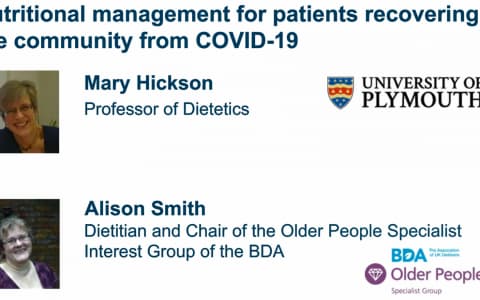
- Educational Videos
- Videos
Nutritional management for patients recovering in the community from COVID-19

- Research
- Videos
The Emerging Trend of Blended Diets; Sharing Best Practice Amongst Healthcare Professionals

- Educational Videos
- Videos
How the application of a digitally supported weight loss programme can support remission in Type 2 diabetes webinar

- Research
- Article
Tolerance and Acceptability of a New Paediatric Enteral Tube Feeding Formula Containing Ingredients Derived From Food: A Multicentre Trial In The United Kingdom

- Product Resources
- Article
Checklist for starting a child on a blenderised diet: using Compleat® paediatric as a base
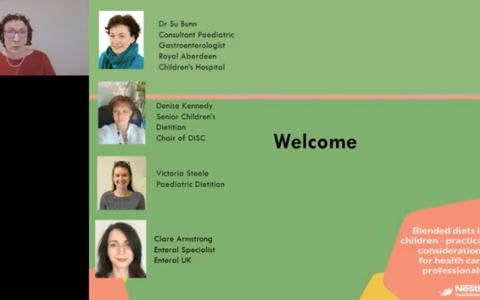
- Educational Videos
- Videos
A Practical Implementation of Blended Diets for Healthcare Professionals Webinar

- Case Studies
- Article
Promoting enteral feeding tolerance in patients with neurodegenerative disorders

- Case Studies
- Article
The use of Peptamen® products in the community with a Head and Neck Cancer patient

- Case Studies
- Article
Nutrition Support for Major Trauma on ICU: meeting requirements & overcoming feed intolerances

- Case Studies
- Article
The use of peptide feed to resolve tolerance issues in a jejunally fed post-op cancer patient

- Case Studies
- Article
Enteral feeding in a HIV positive patient with opportunistic gastric infections
Other content you might be interested in

Dysphagia
- Educational Materials |
Nutrition & Hydration Week Poster Pack

- Podcast
A multi-disciplinary team approach to dysphagia management
0h33- Podcast

Enteral Nutrition
- Webinar |
- Videos
Advancing Enteral Nutrition: Exploring food-derived ingredients options
- Videos

Enteral Nutrition
- Research |
Tolerance and compliance clinical trial of a standard adult enteral tube feed with food-derived ingredients

Cows' Milk Allergy
- Webinar |
- Videos
The Appropriate Use of Amino Acid Formulas
- Videos

Blended Diet Network Annual Event
- Webinar |
- Videos
Blended Diet Network – Full event recording of HCP event & live Q&A
- Videos
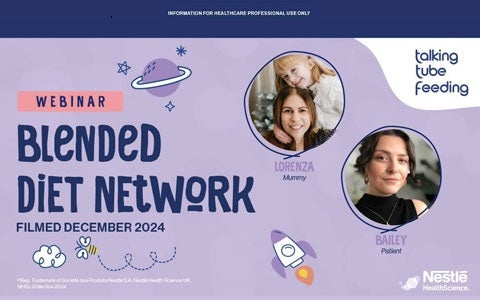
Blended Diet Network Annual Event
- Webinar |
- Videos
Blended Diet Network – Caregiver and patient event with Lorenza and Bailey
- Videos

Blended Diet Network Annual Event
- Webinar |
- Videos
Blended Diet Network – HCP event with Joanna Injore and Michelle Barry
- Videos

Oncology
- Webinar |
- Videos
Malabsorption in Complex Adult Oncology Patients: A nutrition support case study
- Videos

- Podcast
Managing Enteral Nutrition Patients in the Community as a Paediatric Specialist Dietitian
- Podcast

- Podcast
The Impact of Fibre Inclusion in Enteral Nutrition for Paediatric Patients
- Podcast

Enteral Nutrition
- Educational Videos |
- Videos
Roundtable Discussion Series Episode 3: Practical considerations for the future of home enteral feeding and the potential of having a tube feed with food-derived ingredients for adults
- Videos


